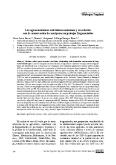| dc.description.abstract | Land use change by the intensification of agriculture contributes to tropical forest fragmentation
and biodiversity loss. In this sense, in comparison with traditional agroforestry systems (AFS), modern
AFS are considered irrelevant for the conservation of biodiversity of tropical forest fragments. However, there
is an increasing trend toward the establishment of different types of modern AFS. Owing to the sensitivity to
environmental changes, we evaluated the biodiversity of butterflies in AFS with Coffea arabica and Erythrina
poeppigiana (CP), and intermixed with Musa spp. (CPM) or Cordia alliodora (the only native species of AFS)
(CPL), as well as premontane very humid forest fragments in the Volcánica Central-Talamanca Biological
Corridor, Costa Rica. In six representative sites of each system we set up three parallel 80 m line-transects, separated
by a distance of 25 m. Each coffee farm and forest fragment (FR) was surveyed during 1.5 hours to record
butterflies. All sites were sampled once a month from May to July 2007. We obtained 4.5 hours of sampling/
site, and 27 hours of sampling/habitat. Both CP and CPM together had a butterflies’ species composition which
differed from CPL and FR. The indicator species of both CP and CPM together were Hermeuptychia hermes and
Anartia jatrophae which are typical of open areas. CPL resulted with the species of secondary forests Heliconius
erato petiverana and Pareuptychia ocirrhoe as indicators. In contrast, FR resulted with several indicator species
typical of closed canopy forests such as Pierella helvina incanescens, Caligo eurilochus, and Morpho peleides
limpida. Moreover, the richness of species was similar among coffee AFS. Furthermore, the richness of species
of each coffee AFS was lower in comparison with FR. However, among coffee AFS, CPL harbored higher
diversity (Exp(H’)) of forest butterflies than CP. Also, CPM was higher in abundance of frugivorous butterflies
in relation with CP and CPL. In fragmented forests, coffee farms with exotic shade species combined at least
with a native tree or fruit species, can be a better habitat for forest butterflies than those dominated by an exotic
monospecific shade. | es_ES |


